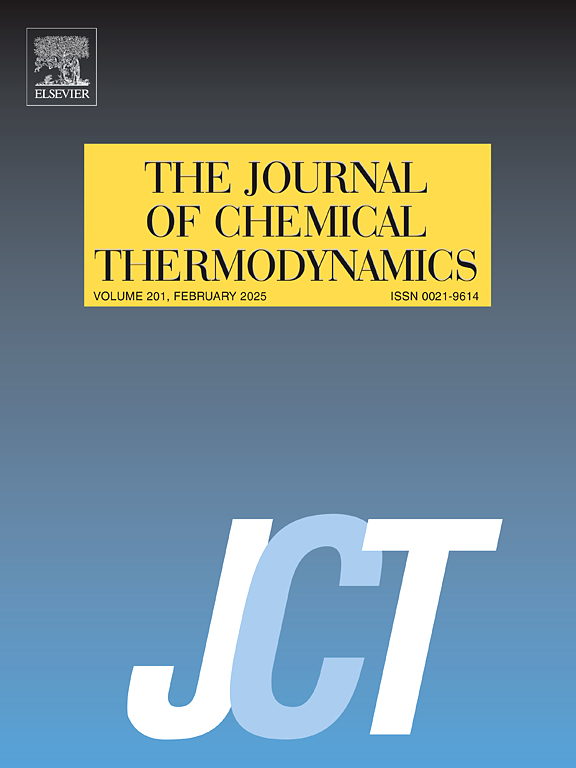Quaternary and its sub-ternary systems of 4-formylbenzoic acid + p-toluic acid + p-phthalic acid + N,N-dimethylformamide: Phase diagrams and DFT studies on adduct of p-phthalic acid with N,N-dimethylformamide
IF 2.2
3区 工程技术
Q3 CHEMISTRY, PHYSICAL
引用次数: 0
Abstract
The equilibrated solubility of the three systems p-phthalic acid (PTA) + p-toluic acid (p-TLA) + N,N-dimethylformamide (DMF), PTA + 4-formylbenzoic acid (4-FBA) + DMF, and p-TLA + 4-FBA + DMF at 298.15 K, 323.15 K and 353.15 K, as well as the quaternary system PTA + p-TLA + 4-FBA + DMF at 298.15 K, was ascertained through experimentation by a Schreinemakers' wet residue method under p = 101.0 kPa. One quaternary isothermal phase diagram and nine ternary isothermal phase diagrams were developed based on the solubility obtained herein. Two distinct neat compounds were produced in ternary systems, comprising the PTA·2DMF adduct (mole ratio of PTA to DMF, 1:2) at 323.15 K and 298.15 K, or PTA at a temperature of 353.15 K, along with p-TLA in the PTA + p-TLA + DMF system; 4-FBA and p-TLA in the 4-FBA + p-TLA + DMF system; and the PTA·2DMF adduct at 298.15 K and 323.15 K, or PTA at 353.15 K, combined with 4-FBA in the PTA + 4-FBA + DMF system. The adduct PTA·2DMF was observed at temperatures below 323.15 K for PTA in DMF. Each diagram for ternary systems comprised two cosaturated point curves, one cosaturated point, and three crystalline regions. The ternary and quaternary phase diagrams presented in this study may serve as a foundation for the separation of PTA from p-TLA, 4-FBA, and PTA mixtures. The formation of the PTAˑ2DMF adduct involves favorable weak interactions, specifically hydrogen bonds and van der Waals forces, as analyzed through the Hirshfeld partitions-based independent gradient model, electron density difference maps, density differences, ELF difference maps, and 2D fingerprint plot analysis.
4-甲酰苯甲酸+对苯甲酸+对邻苯二甲酸+ N,N-二甲基甲酰胺的四元及其亚三元体系:对邻苯二甲酸与N,N-二甲基甲酰胺加合物的相图和DFT研究
采用Schreinemakers湿残法,在p = 101.0 kPa条件下测定了对邻苯二甲酸(PTA) +对甲苯(p- tla) + N、N-二甲基甲酰胺(DMF)、PTA + 4-甲酰苯甲酸(4-FBA) + DMF、p- tla + 4-FBA + DMF三种体系在298.15 K、323.15 K和353.15 K时的平衡溶解度,以及PTA + p- tla + 4-FBA + DMF四元体系在298.15 K时的平衡溶解度。根据所得的溶解度,绘制了一个四等温相图和九个三元等温相图。在323.15 K和298.15 K下,PTA·2DMF加合物(PTA与DMF的摩尔比为1:2)和353.15 K下,PTA + p-TLA + DMF体系中的p-TLA组成了两种不同的整齐化合物;4-FBA + p-TLA + DMF体系中的4-FBA和p-TLA;PTA·2DMF加合物在298.15 K和323.15 K,或PTA在353.15 K,与4-FBA在PTA + 4-FBA + DMF体系中结合。在低于323.15 K的温度下,在DMF中观察到PTA·2DMF的加合物。三元体系的每个图由两个共饱和点曲线、一个共饱和点曲线和三个结晶区域组成。本研究的三元和四元相图可以作为PTA从p-TLA、4-FBA和PTA混合物中分离的基础。通过基于Hirshfeld分割的独立梯度模型、电子密度差图、密度差图、ELF差图和二维指纹图分析,PTA a . 2DMF加合物的形成涉及有利的弱相互作用,特别是氢键和范德华力。
本文章由计算机程序翻译,如有差异,请以英文原文为准。
求助全文
约1分钟内获得全文
求助全文
来源期刊

Journal of Chemical Thermodynamics
工程技术-热力学
CiteScore
5.60
自引率
15.40%
发文量
199
审稿时长
79 days
期刊介绍:
The Journal of Chemical Thermodynamics exists primarily for dissemination of significant new knowledge in experimental equilibrium thermodynamics and transport properties of chemical systems. The defining attributes of The Journal are the quality and relevance of the papers published.
The Journal publishes work relating to gases, liquids, solids, polymers, mixtures, solutions and interfaces. Studies on systems with variability, such as biological or bio-based materials, gas hydrates, among others, will also be considered provided these are well characterized and reproducible where possible. Experimental methods should be described in sufficient detail to allow critical assessment of the accuracy claimed.
Authors are encouraged to provide physical or chemical interpretations of the results. Articles can contain modelling sections providing representations of data or molecular insights into the properties or transformations studied. Theoretical papers on chemical thermodynamics using molecular theory or modelling are also considered.
The Journal welcomes review articles in the field of chemical thermodynamics but prospective authors should first consult one of the Editors concerning the suitability of the proposed review.
Contributions of a routine nature or reporting on uncharacterised materials are not accepted.
 求助内容:
求助内容: 应助结果提醒方式:
应助结果提醒方式:


